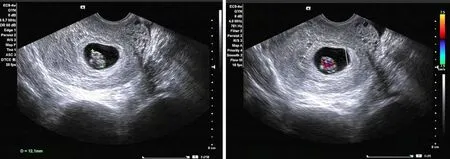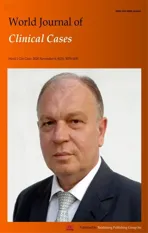Early ultrasound diagnosis of conjoined twins at eight weeks of pregnancy: A case report
2020-04-07XiaoWenLiangYongYiCaiYaoZhangYangZhiYiChen
Xiao-Wen Liang, Yong-Yi Cai, Yao-Zhang Yang, Zhi-Yi Chen
Xiao-Wen Liang, Yao-Zhang Yang, Zhi-Yi Chen, Department of Ultrasound Medicine, The Third Affiliated Hospital of Guangzhou Medical University, Guangzhou 510000, Guangdong Province, China
Yong-Yi Cai, Department of Ultrasound, Liwan Hospital of the Third Affiliated Hospital of Guangzhou Medical University, Guangzhou 510000, Guangdong Province, China
Abstract BACKGROUND Conjoined twins are a rare occurrence, and the majority of these malformations are detected during second trimester screening.CASE SUMMARY Herein we report a case of conjoined twins, which was diagnosed by ultrasound at 8 wk gestation and was normal at 7 wk gestation. The two fetuses shared one heart and were diagnosed as thoracopagus twins. This is the first report of conjoined twins diagnosed at 8 wk gestation. The pregnancy was terminated electively at 9 wk gestation. Because some congenital malformations can be diagnosed earlier, a prenatal ultrasound examination at an early gestational stage cannot be dismissed.CONCLUSION This case demonstrates that a 7-8 wk gestation might be the earliest period when conjoined twins can be diagnosed by ultrasound.
Key Words: Conjoined twins; Ultrasound; Thoracopagus; Early diagnosis; Congenital malformation; Case report
INTRODUCTION
Conjoined twins are extremely rare fetal abnormalities with a reported prevalence of 1:50000-1:100000[1]. Conjoined twins result from postzygotic splitting 13 d after fertilization[2]. Approximately 70% of conjoined twins die within 24-48 h after birth or have a fatal congenital disease; thus, early diagnosis and treatment are desirable[3]. In a previous study, conjoined twins were diagnosed by ultrasound between 18 and 22 wk gestation[4]. More recent research has reported the diagnosis of fetal defects in twin pregnancies at 11-13 wk gestation[5]. Termination of pregnancy as early as possible continues to be the best treatment. Herein we report a case of conjoined twins suspected of cardiac fusion diagnosed by prenatal ultrasound at 8 wk gestation and confirmed by surgery.
CASE PRESENTATION
Chief complaints
At 8 wk gestation, a pregnant woman presented with low progesterone level.
History of present illness
A 30-year-old woman had a normal prenatal ultrasound examination at 7 wk gestation. The patient did not have any other discomfort.
History of past illness
The patient is G4P1. She delivered her first child vaginally.
Personal and family history
The patient has no special family history.
Physical examination
The patient’s physical examination was normal.
Laboratory examinations
Laboratory testing had revealed a low progesterone level.
Imaging examinations
The first prenatal transvaginal ultrasound was performed by CD-6 (Mindray,Shenzhen, China) at 7 wk gestation. Two-dimensional ultrasound images showed that the embryo was normal with crown-rump length of 12 mm (Figure 1).
After 7 d, the prenatal ultrasound was performed again using a Volusion E8 (GE Healthcare, Milwaukee, WI, United States). Two-dimensional ultrasound images showed a single yolk and two embryos in the gestational sac. The lengths of the two embryos were 18 mm and 20 mm. The embryos were connected without distinct boundaries, and there was no fluid between them. The two embryos shared one heart.Color Doppler flow imaging showed that pulsating blood flow signals existed at the junction of the two embryos (Figure 2).

Figure 1 Ultrasound imaging of the embryo at seven weeks gestation.

Figure 2 Ultrasound imaging of the embryo at eight weeks gestation. A: Two embryos and two spines can be seen in the long axial view; B: Two brains can be seen in the short axial view; C: Two gastric vacuoles and two bladders can be seen; D: Color Doppler flow imaging showed that the two embryos had only one beating heart.
FINAL DIAGNOSIS
Conjoined twins (thoracopagus twins).
TREATMENT
Terminated the pregnancy through abortion.
OUTCOME AND FOLLOW-UP
Discharge after a period of observation.
DISCUSSION
Conjoined twins are very rare monozygotic variants, most of which are monochorionic monoamniotic twins[6]. Although the basis of conjoined twins has not been established,there are two main theories. The first theory is that incomplete division of an early embryo produces identical twins with the same anatomic structures. The other theory is that conjoined twins are the result of two separate embryos reuniting again.
Conjoined twins are classified based on the conjoined body parts. The most common type of conjoined twins is an abdominal union, which accounts for 87% with a mortality rate of 51%, while dorsal unions occur in up to 13% of conjoined twins[7,8].Cardiac fusion usually occurs in thoracopagus twins, but rarely occurs in ischiopagus,craniopagus, or pygopagus twins. Along with the improvements in surgical technique,survival rates for separation procedures have increased. Although cardiac fusion is relatively common in conjoined twins, the success rate of surgical separation and diagnostic accuracy for this type is extremely low.
In most cases of conjoined twins, a severely deformed connection is fatal for the surviving fetus[9]. However, severe malformations are always caused by the untimely diagnosis, which delays optimal surgical treatment. Chenet al[10]studied the outcomes of postnatal surgical separation of conjoined twins diagnosed before 15 wk gestation.The survival rate of emergency surgery (10%-29%) was reported to be much lower than nonemergent, planned surgery (81%-83%). Recently, Heueret al[11]successfully separated total-fusion craniopagus twins at 10 mo of age. Dunaway[12]concluded that there are many unknowns regarding the research of separating craniopagus twins in stages. Moreover, in couples who opt to continue the pregnancy, a multidisciplinary team for prenatal and postnatal management is necessary because multiple malformations are often found[13].
It was also demonstrated that early diagnosis of conjoined twins is necessary. Early diagnosis of conjoined twins has the following advantages. First, through the early evaluation of the degree of fusion, the optimal treatment time and strategy can be selected. In addition, early diagnosis will minimize maternal and fetal mortality. Early evaluation will also help parents to choose early termination, thereby reducing the risk of trauma during vaginal delivery[14].
CONCLUSION
In conclusion, the incidence of conjoined twins is low, but the rate of mortality and malformations (such as severe congenital lung disease) is high. Termination of pregnancy may be a wise choice, especially when the vital organs of the body are connected. This study suggests that active and regular antenatal ultrasonic examinations provide a great opportunity for good prognosis. Interdisciplinary integration also plays an important role in the diagnosis and treatment of conjoined twins[15]. We suppose that an ultrasound examination at 7-8 wk of pregnancy plays an important role in the early diagnosis of congenital malformations in twins. Therefore,apart from the heartbeat and calculation of gestational age, sonographers should also notice the fetal structure in early examinations.
杂志排行
World Journal of Clinical Cases的其它文章
- Strategies and challenges in the treatment of chronic venous leg ulcers
- Peripheral nerve tumors of the hand: Clinical features, diagnosis,and treatment
- Treatment strategies for gastric cancer during the COVID-19 pandemic
- Oncological impact of different distal ureter managements during radical nephroureterectomy for primary upper urinary tract urothelial carcinoma
- Clinical characteristics and survival of patients with normal-sized ovarian carcinoma syndrome: Retrospective analysis of a single institution 10-year experiment
- Assessment of load-sharing thoracolumbar injury: A modified scoring system
